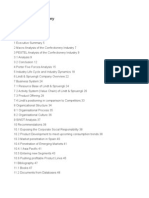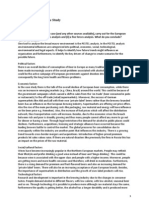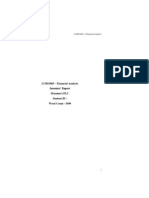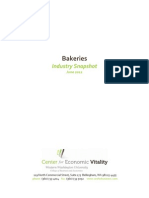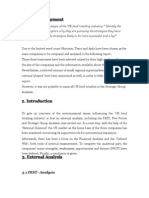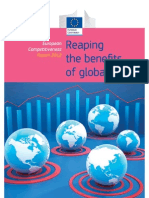Business
Uploaded by
Jason CkhBusiness
Uploaded by
Jason CkhTable of Content
Table of Content.......................................................................................... 1 Question 1................................................................................................... 2 PEST analysis............................................................................................ 2 Porters 5 forces....................................................................................... 4 Question 2................................................................................................... 5 Michael Porter's Generic Competitive Strategies......................................5 Threshold Resources .............................................................................. 6 Core Resources........................................................................................ 6 Question 3 .................................................................................................. 7 Ansoff Matrix............................................................................................ 7 Market penetration ................................................................................. 8 Product development and Market development.......................................8 Organic development............................................................................... 9 Question 4 .................................................................................................. 9 Johnson and Scholes framework of Suitability, Feasibility and Acceptability........................................................................................... 10 SABMillers strategic priorities: ...........................................................10 Constraint of acquisitions.......................................................................12 Reference.................................................................................................. 13
Page 1 of 14
Question 1 Using information exclusively from the European Brewing Industry and SABMiller cases as supplied and appropriate models from the course analyse the external environment in which SABMiller operated in 2010. After conducted a series of cross broader mergers and acquisitions SABMiller successfully become the second largest brewer by volume in the world. SABMiller is now operating worldwide: Latin America, Europe, North America, Africa, Asia, and South Africa. Nevertheless, the environmental condition and potential of growth vary between each region (Blee and Whittington, 2010). European brewing industry was one of the worlds major beer consumption regions. Recent years, the market has come into mature stage of the industry life cycle and demand is now decreasing (Euromonitor, 2010). PEST analysis and Porter five forces model are the appropriate methods to evaluate external environment on European Brewing Industry (Johnson, 2002).
PEST analysis Political / Legal Governments were strongly against drunken driving, meanwhile, increasing the awareness of the effects of alcohol on health and fitness. This campaign has beaten beer consumption and furthermore shifted the selling pattern from on-trade (sales in restaurants or pubs) to off-trade (retails) (Blee and Whittington, 2010). European Union has created the competition law to ensure the completion of the internal market and aim to restrict excessively monopolies, mergers, cartels and state aid (EU Competition Law, 2010). For instance, European Commission has imposed a fined on Heineken and Kronenbourg because of acting cartels. Due to the same reason, many medium-sized brewers had withdrawn from European market (Blee and Whittington, 2010). Economic According to Johnson (2010) and Blee and Whittington (2010), Europe was facing an economic recession at the end of decade and this affected the overall beer markets. As stated in the case, in United Kingdom, estimated 50 pubs end up per week during recession year. Page 2 of 14
In addition, the European brewers were facing costs pressure from packaging and raw material. In Europe there are only few international companies dominating the packaging industry thus brewers have less bargaining power to cut costs. This factor cause the increasing of costs and pull down the profit margin (Blee and Whittington, 2010). Social Since the governments campaigned strongly against drunken driving and other negative effects of alcohol, the sales of beer was dropped significantly. People have reduced their leisure time spending in pubs and shifted to other completing leisure activities. The social lifestyle is changing people now prefer wine, cider, and spirits than consumed beer in pubs. This is a critical factor that cause beer consumption fell by 21.66 per cent from 1980 to 2007 in UK (Blee and Whittington, 2010). Technological Due to the increasing of production costs, brewers had invested major in research and development to achieved economy of scale, improved productivity and logistics to compete more effectively in the markets (Johnson, 2010). SABMiller was successfully reducing water consumption across its global operations (SABMiller, 2010). In summary, external environment of Europe in 2010 was unfavourable to SABMiller. Political, economic recession and social trend were significantly damaged the sale of beer in European markets. However, SABMiller was performed very well in research and development to continuously cut the cost down while improves the quality.
Page 3 of 14
Porters 5 forces
Source: Porter (1985) and own source. The threat of entry-High The increasing of consolidation by mergers and acquisitions in brewing industry had made the requirement of entry become higher. In 2009, the worlds top tem brewing companies had dominated 60 per cent of world beer volume (Johnson, 2010). To enter the markets, a new entrant has to invest majority in capital assets and obtain different capabilities to compete in both global and local markets, which create major barriers to entry. The threat of substitutes-High Due to the governments campaign against beer and changing in social lifestyle, people tend to non-alcohol drinks (wine, cider and spirits) and other competing leisure activities (Blee and Whittington, 2010). The power of buyers-High Europe markets were in the mature stage and saturated, buyers need innovative brands or products. Furthermore, the switching cost is low thus buyers were highly variable (Blee and Whittington, 2010). The power of suppliers-Low Those large brewing companies SABMiller and Anheuser-Busch InBev have greater influence in reducing the costs because they purchased in large
Page 4 of 14
quantity (Johnson, 2010). In contrast, those smaller brewing companies who purchase lower quantity have less bargaining power to suppliers.
Competitive rivalry- High The increasing of consolidation and impact on globalization incurred competition intensively. Competitors were not mainly competing inside the Europe markets but also in oversee emerging markets, for example Latin America and Asia (Johnson, 2010). In summary, the attractiveness of brewing industry is moderate because of intensive rivalry, other substitutes products and high buyer bargaining power. However, SABMiller is the world 2nd largest brewing company thus it can create barriers to impede new entrants and more bargaining power to suppliers.
Question 2 What is SABMillers current competitive advantage and how does it coordinate its threshold and core resources and skills to compete in this industry?
Michael Porter's Generic Competitive Strategies
Michael Porter had introduced three generic strategies that are commonly used by businesses to achieve competitive advantage: cost Page 5 of 14
leadership, differentiation, and focus (either cost or differentiation). Definitely, SABMiller is using differentiation strategy that widely valued by consumer to achieve competitive advantage (Lester, D. L., Parnell, J. A., and Menefee, M. L., 2008).
Threshold Resources After a series of mergers and acquisitions, now SABMiller is presence in more than 60 countries (broad market scope) and offering premium beers that adaption to local consumers taste (uniqueness) (Beverageworld, 2009). SABMiller has to co-ordinate its threshold capabilities and core resources and skills to achieve sustainable competitive advantage. Threshold capabilities are the minimum requirement to compete in the given market, but it can be a critical success factors (Johnson, Scholes, and Whittington, 2008). For example, in those emerging markets, drinkers are strongly attached to local brand thus SABMiller has to meet the minimum customer requirement by producing and upgrading local brand (Johnson, 2010). Another threshold resource need in brewing industry is strong financial resource. Other than heavily investment in capital assets (machines and equipment), consolidations also become a trend to survive and prosper in brewing industry. Thus a strong financial backup become necessary for SABMiller to compete in an intensively competitive environment (The economist, 2007). For example, in 2002, SAB spent approximately USD 5.6 billion to acquire American brewer Miller, forming SABMiller and become a global beer giant that ranking 2nd of the world (Walsh, 2009). In addition, SABMiller launched a series of mergers and acquisitions to enter emerging markets, for example China, India, Latin America, and much of the Europe. Although SABMiller spent a lot in consolidations, it has successful.
Core Resources The core competences of SABMiller are its expertise which has been gained over 100 years in South Africa and its strong brand recognition (Johnson, 2010). These core resources are valuable and inimitable by competitors. In the emerging markets, local brewers were producing in smallscale, low quality beer, and brewing remained highly fragmented, therefore SABMiller used its expertise and know-how to develop beer in emerging markets. For instance, SABMiller is continuous do the research in reducing water consumption to produce more beer with quality. In 2010, the efficiency of water use let SABMiller spend only 722 million hectolitres to produce the beer and it was 4% improvement compare to previous year (SABMiller, 2010). Although Anheuser-Busch InBev is the world largest brewing company, it was just mainly focus on local monopoly. Anheuser-Busch InBev has Page 6 of 14
dominated nearly 50 per cent market share in both United Stated market and Mexico market, most of its profits were came from developed markets (Johnson, 2010). In contrast, SABMiller was more focusing on emerging markets and 85 per cent of its profits were generated through overseas (CNNMoney, 2010). The result showed that SABMiller was always performed well in emerging markets through its expertise and experience. In emerging markets, SABMiller usually deployed its expert operational management skills learnt in South Africa to manage the overseas markets. Initially, SABMiller will rationalize the brand portfolio and upgrade quality. Next is improving productivity, marketing and distribution to get synergy and cost efficiency. On the other hand, SABMiller also build a good relationship with local government, partners, and communities (Johnson, 2010). As result, SABMiller was getting a healthy profit margin in emerging markets.
Question 3 Identify the different directions in which South Africa Breweries has grown since it began and the strategic rationale for this pattern of growth.
Ansoff Matrix
Source: Ansoff, H., Corporate Strategy, Penguin, (1988) Over the years, SABMiller was following Ansoff matrix for strategic development to expend its businesses (Johannesson, 2009). Initially, SABMiller was concentrated it business on South Africa by using market penetration strategy. Next, it moves forward to product development. In past
Page 7 of 14
four decades, SABMiller has shifted toward market development that intensively expands to emerging markets.
Market penetration SABMiller was begun in 1895 and it is foundational in South Africa (Dabechuran, 2011). During 19th century, SAB was facing challenges of apartheid regime and the government was restricted international business in South Africa. Therefore, SAB adopted market penetration strategy to focus on dominating the brewing industry in South Africa markets (McQuade, 2007). To achieve the target, SAB was actively in expansions within brewing sector, principally through acquisition of competitors (Mager, 2008). After expended its market share, SAB started in product development, for example increase product portfolio, improve brand quality, increase efficiency of productions, and rationalize distribution facilities (McQuade, 2007). As result, SAB successfully control 99% of the markets in South Africa by 1979. Meanwhile, SAB gained the first-mover advantages in South Africa by incurred serious deterrent to entrants and achieved technological leadership (expertise) through experience curve (Johnson, 2010).
Product development and Market development In the beginning of 2000, South Africa brewing was reached maturity stage in the industry life cycle and the market was saturated (Maksimovic and Phillips, 2008). To seek the opportunity of growth, SAB has to expand in new markets by adopting market development strategy. In 1993, SAB made its first acquisition abroad in Europe, Hungary largest brewery, Dreher. Next, SAB acquired American Miller Brewer in 2002 forming SABMiller become second largest brewer in the world and occupied major market share in Latin America (RUNS ON BEER, 2011). SABMiller subsequently enter those emerging markets through mergers and acquisitions, for example Latin America, Asia, and rest of Africa (Johnson, 2010). The focus on emerging markets was the key factor that made SABMiller successful in global brewing industry. According to Fortunes 2010 Worlds Most Admired Companies survey, SABMiller was ranking at number 3 (Cendrowski, 2010). The opportunities in emerging markets involve, economy grows rapidly, fast-expanding, profitable, and there were remained high fragmentation. SABMiller usually acquired or joint venture with local partners to enter the market. In operation, SABMiller retained the local brand by upgrading the brand portfolio and increased efficiency in production and distribution to deliver better marketing proposition. In management, SABMiller introduced the traditional SAB management system, for example decentralization and reward strong performers (Johnson, 2010). Page 8 of 14
There were some challenges in this market development: over depend on emerging markets and influence of stakeholders. Although SABMiller grown rapidly, it was over depend on emerging markets. Stakeholder started to lose confidence because of devaluation of soft currencies across emerging markets (Jacob, 2009). Therefore, stakeholder required SABMiller enter into developed markets to access world capital markets and diversified currencies and geography risk (Johnson, 2010).
Organic development In recently, the opportunities of mergers and acquisition are shrinking. In addition, economic recession affect the lower prospects of high financial return. SABMillers CEO Graham Mackay said that SABMiller do not need mergers and acquisitions to grow now on a conference call (Fletcher, 2011). Start from 2010, the company is planning to organic growth rather than continue mergers and acquisitions. Now, SABMiller do not follow the Ansoff matrix strategic direction and avoid diversification. Many of the research studies showed that company performance will drop if extensively in unrelated diversification (Bar, 2007). There are some reasons for SABMiller to choose organic development: Nature of markets, highly technical products, knowledge and capability development, and minimising disruption. Since there is an opportunity shrinking in mergers and acquisitions, SABMiller has to go on organic growth. Furthermore, SABMiller occupied greater knowledge and capability in brewing through its 100 years experience operating in South Africa. Therefore, these capabilities become the core competency to compete successfully (Johnson, Scholes and Whittington, 2008).
Question 4 Using the strategic priorities outlined in Table 1 of the case evaluate the strategic options that SABMiller now faces and consider what might constrain their use of acquisitions as a means of growth in the future.
Page 9 of 14
Johnson and Scholes framework of Suitability, Feasibility and Acceptability
Source: Johnson and Scholes, 2010. An environmental scan (external and internal) is extremely important to evaluate the efficiency of an organizational strategy. Particularly, Johnson and Scholes framework of Suitability, Feasibility and Acceptability is best to use in evaluate SABMillers current strategic options (Johnson and Scholes, 2010). Suitability Suitability is concerned whether the strategic options are compatible with external environment-PEST analysis and Porter five forces. Feasibility Feasibility is an evaluation of companys internal capability whether the company has adequate resources to pursue the strategic choices. The 6M resources are included in feasibility: Money, Manpower, Markets, Machinery, Materials, and Mark-up to determine the capabilities of a company. Acceptability Acceptability is focus on two aspects: financial aspect (return and risk) and stakeholder aspect (interaction between strategic options and stakeholders reaction).
SABMillers strategic priorities: 1. Creating a balanced and attractive global spread of businesses (Market Development Strategy).
Page 10 of 14
As mentioned, global brewing industry was entered into maturity stage of industry life cycle and demand was dropped. SABMiller has to capture new growth in emerging markets by exploiting current products and capabilities to enter new market segments. The strategy of global spread was matched and compatible with current external environment situation, so it meets the criteria of suitability. SABMiller has great experienced and core resources (financial and managerial) in doing mergers and acquisitions in emerging markets. Strong management team help SABMiller regulating the emerging markets very well (Johnson, 2010). Stakeholders were required to balance the global presence in both developed and emerging markets. SABMiller was successfully generated huge profits from emerging markets, for example, Latin America contributed 31 per cent of profits to SABMiller group in 2010 (SABMiller, 2010).
2. Developing strong, relevant brand portfolios in the local market (Product Development Strategy). According to consumer behaviour, drinkers have strongly attachments to local beer and they were highly retained to local brand. This is the reason that SABMiller keep developing an attractive local brand that meets consumers needs in each market (Johnson, 2010). For example, SABMiller created Snow brand particularly for China consumers. In addition, SABMiller also produced the premium brand to satisfy affluent consumers that they have higher expectations to beer. SABMillers expertise is the core competency to exploit knowledge of consumers needs and therefore produce better beers. By adding value to the premium beer, SABMiller is able to charge higher price to affluent consumers and increase the margin of profit.
3. Constantly raising the performance of local businesses (similar to Product Development Strategy). Due to increasing of material costs, SABMiller is struggling to achieve cost efficiency. In 2008, SABMiller had reduced its water use per litre of beer by 25 per cent to produce same volume of high quality beer (SABMiller, 2010). SABMiller improve its performance by decentralize local managers. Each local manager has the authority to make decision due to fast changing
Page 11 of 14
of market conditions and consumers needs. This allowed SABMiller be more flexible in operation management.
4. Leveraging our global scale. Globalization has boosted the international business, so SABMiller must look the global as a whole rather than focus on part of it. SABMiller increase its global present through a serious of mergers and acquisitions and it was very successful. Mergers and acquisitions allowed SABMiller get synergy. Synergy is achieved through combine by two or more firms and creating opportunities that would not been available to these firms operating independently. Benefits of synergy can divide into operating synergy (economies of scale, greater pricing power, and higher growth in markets) and financial synergy (cash slack, increase debt capacity, and tax benefits) (Damodaran, 2005). In summary, SABMillers current strategic priorities are accepted and it could get SABMiller achieve sustainable competitive advantages.
Constraint of acquisitions By 2010, SABMiller group announced to change its strategy from acquisitions to organic growth (Johnson, 2010). According to Investopedia.com, an estimated 66% of mergers and acquisitions are not successful and there are some factors constrain the use of acquisitions as a means of growth in the future. First, the global brewing industry is in the maturity stage and less consolidated opportunities. During 2000s, large brewing companies like Anheuser-Busch InBev, SABMiller, and Heineken had done a series of acquisitions. This action had reduced the number of competitors in the same time also reduce the consolidation opportunities. Second, value destruction usually happened in mergers and acquisitions. The purpose of mergers and acquisitions is to get synergy but most of them failed due to the different culture between companies and countries. Finally, the cost of acquisition is extremely expensive. Although the cost of organic growth is probably higher than acquisition, it can spread the investments over time (Johnson, Scholes, and Whittington, 2008). Furthermore, organic growth can avoid disruption by developing an organizations own capability. Page 12 of 14
Reference Bar, M., Niessen, A. and Ruenzi, S. (2007), 'The Impact of Work Group Diversity on Performance: Large Sample Evidence from the Mutual Fund Industry. Beverageworld (2009), SABMiller Grows From 'Dusty Operation' Into a Global Giant [online], Available from: http://www.beverageworld.com [Accessed: 2.6.2011]. Blee, M and Whittington, R. (2010) 'Global forces and the Western European brewing industry' Cendrowski, S. (2010), SABMiller has its eye on emerging markets [online], Available from: http://cnnmoney.com [Accessed: 2.6.2011]. CNNMoney (2010), SABMiller - Foster's: The latest froth in M&A [online], Available from: http://money.cnn.com/2010/08/23/news/companies/SABMiller_Fosters.html [Accessed: 2.6.2011]. Dabechuran, A. (2011), 'The challenges facing South African Breweries (SAB) when the new Liquor Act is implemented.' Damodaran, A. (2005), 'The Value of Synergy', Stern School of Business, . Donald L. L., John A. P., and Michael L. M. (2008) "Organizational life cycle and performance among SMEs: Generic strategies for high and low performers", International Journal of Commerce and Management, Vol. 18 Iss: 4, pp.313 330 EU Competition Law Rules Applicable to Merger Control (2010). Euromonitor (2010), Beer in the United Kingdom [online], Available from:http://www.euromonitor.com/beer-in-the-united-kingdom/report [Accessed: 29.5.2011]. Fletcher, C. (2011), SABMiller Studying Acquisitions and Organic Growth, CEO Says [online], Available from: http://www.bloomberg.com/news/2011-0519/sabmiller-studying-htacquisitions-and-organic-growth-ceo-says.html [Acces sed: 2.6.2011]. Jacob, T. (2009), 'SABMiller: Strategy Position in 2007 and it's Future Implications'. Page 13 of 14
Johannesson, J. (2009), 'The Ansoff Matrix revisited', Northampton Business School, London. Johnson, G (2010), 'Case Study: SABMiller'. Johnson, G and Scholes, K. (2002) Exploring Corporate Strategy, Text and Cases sixth edition, Prentice Hall Johnson, G. and Scholes, K. (2010), 'Strategic choice- Johnson and Scholes Suitability, Feasibility, and Acceptability Framework'. Johnson, G., Scholes, K. and Whittington, R. (2008) Exploring Corporate Strategy, Text and Cases eighth edition, Prentice Hall Mager, A.K. (2008), 'Apartheid and business: Competition, monopoly and the growth of the malted beer industry in South Africa Business History', London, 50, 3, pp. 272 - 290. Maksimovic, V. and Phillips, G. (2008), 'The Industry Life Cycle, Acquisitions and Investment: Does Firm Organization Matter?', The Journal of Finance, 63, 2, pp. 673 708. McQuade, A. (2007), 'SABMiller'. Pretorius, M. (2008), 'When Porter's generic strategies are not enough: complementary strategies for turnaround situations', Journal of Business Strategy, 29, pp. 19-29. RUNS ON BEER (2011), AB-InBev / SAB Miller Merger [online], Available from: http://runsonbeer.com/2011/02/ab-inbev-sab-miller-merger/ [Accessed: 2.6.2011]. SABMiller (2010), Company Snapshot 2010 [online], Available from: http:// www.sabmiller.com [Accessed: 5.6.2011]. Schmitt, C. (2011), Marketing aspects of the brewing industry, GRIN Verlag. The Economist (2007), Beer mergers: Another Round? A tie-up between two American brewers leads to talk of furthe mergers [online], Available from:http://www.economist.com/node/9962447/print [Accessed: 2.6. 2011]. Walsh, D. (2009), Times Newspapers [online], Having splashed out on Miller, Grolsch and Peroni, SAB is still thirsty for more, [Accessed: 1.6.2011].
Page 14 of 14
You might also like
- MGT3324 Strategic Management: Student Name: Student IDNo ratings yetMGT3324 Strategic Management: Student Name: Student ID12 pages
- Cola Wars Continue: Coke and Pepsi in 2010No ratings yetCola Wars Continue: Coke and Pepsi in 20105 pages
- Competition in The Craft Beer Industry in 2016No ratings yetCompetition in The Craft Beer Industry in 20165 pages
- Capital for Champions: SPACs as a Driver of Innovation and GrowthFrom EverandCapital for Champions: SPACs as a Driver of Innovation and GrowthNo ratings yet
- Int MKTG The Global Branding of STELLA ARTOIS 2100% (1)Int MKTG The Global Branding of STELLA ARTOIS 213 pages
- The Global Brewery Industry-National Responsiveness Vs IntegrationNo ratings yetThe Global Brewery Industry-National Responsiveness Vs Integration60 pages
- Impact of The Analysis of The Microenvironment PDFNo ratings yetImpact of The Analysis of The Microenvironment PDF6 pages
- Market and Industry Opportunities Analysis: GlobalisationNo ratings yetMarket and Industry Opportunities Analysis: Globalisation7 pages
- Sample of Assignment Business Plan For Old Town White Coffee33% (3)Sample of Assignment Business Plan For Old Town White Coffee37 pages
- Assignment: Marketing Management - BMK 0101 Mehboob Akhter U1161013 Marketing Management (MSC)No ratings yetAssignment: Marketing Management - BMK 0101 Mehboob Akhter U1161013 Marketing Management (MSC)17 pages
- The Stationery, Office and School Supplies Market in The EUNo ratings yetThe Stationery, Office and School Supplies Market in The EU51 pages
- SWOT and PESTLE Analysis Case Study: Yum: IndexNo ratings yetSWOT and PESTLE Analysis Case Study: Yum: Index10 pages
- Political: PESTLE Analysis of RAW PresseryNo ratings yetPolitical: PESTLE Analysis of RAW Pressery6 pages
- COMPETE Working Paper 3 Trade Import CompetitionNo ratings yetCOMPETE Working Paper 3 Trade Import Competition28 pages
- Perspectives From The Journal of Agrarian Change: Agribusiness For Development': Who Really Gains?No ratings yetPerspectives From The Journal of Agrarian Change: Agribusiness For Development': Who Really Gains?2 pages
- E-Marketing 1: E-Marketing Plan For Cafépod Coffee CompanyNo ratings yetE-Marketing 1: E-Marketing Plan For Cafépod Coffee Company16 pages
- Frozen Chilled and Ready Made Foods Industry GuideNo ratings yetFrozen Chilled and Ready Made Foods Industry Guide5 pages
- Eu Sme Centre Report - The Food and Beverage Market in China Update - July 2015No ratings yetEu Sme Centre Report - The Food and Beverage Market in China Update - July 201547 pages
- Cola Wars Continue Coke and Pepsi in 2010 - Answers To Questions25% (4)Cola Wars Continue Coke and Pepsi in 2010 - Answers To Questions5 pages
- Alice Gavrila From Erika-MG628 International Marketing Management.100% (1)Alice Gavrila From Erika-MG628 International Marketing Management.13 pages
- Report On Strategic Analysis of Oceania Dairy Limited - The Competitive AdvantagesNo ratings yetReport On Strategic Analysis of Oceania Dairy Limited - The Competitive Advantages17 pages
- How Many Grocery Stores Are in The UK Marketing EssayNo ratings yetHow Many Grocery Stores Are in The UK Marketing Essay13 pages
- Section 1: Investment Recommendations: by The Committee Quarterly MonthlyNo ratings yetSection 1: Investment Recommendations: by The Committee Quarterly Monthly13 pages
- United Kingdom The UK Food and Drink Market: Hyatt ConsultingNo ratings yetUnited Kingdom The UK Food and Drink Market: Hyatt Consulting28 pages
- Managing Small and Medium Sized Enterprise: Development Strategy For Turtle BayNo ratings yetManaging Small and Medium Sized Enterprise: Development Strategy For Turtle Bay12 pages
- Dairy Globalization Refresh: 2011 UpdateNo ratings yetDairy Globalization Refresh: 2011 Update19 pages
- Solar Powered Agro Industrial Project of Cassava Based Bioethanol Processing UnitFrom EverandSolar Powered Agro Industrial Project of Cassava Based Bioethanol Processing UnitNo ratings yet
- The New Global Rulers: The Privatization of Regulation in the World EconomyFrom EverandThe New Global Rulers: The Privatization of Regulation in the World EconomyNo ratings yet
- Feeding future generations: How finance can boost innovation in agri-food - Executive SummaryFrom EverandFeeding future generations: How finance can boost innovation in agri-food - Executive SummaryNo ratings yet
- Zagu Foods Corporation: Authorized Dealer DepartmentNo ratings yetZagu Foods Corporation: Authorized Dealer Department6 pages
- Slide CH 7 Multinational Financial ManagementNo ratings yetSlide CH 7 Multinational Financial Management33 pages
- E-Auction Under Insolvency and Bankruptcy Code, 2016No ratings yetE-Auction Under Insolvency and Bankruptcy Code, 20161 page
- Acorn AAT L4 ManagementAccountingDecisionAndControl MockExamOneNo ratings yetAcorn AAT L4 ManagementAccountingDecisionAndControl MockExamOne49 pages
- The Current Legal System On Traditional Knowledge ProtectionNo ratings yetThe Current Legal System On Traditional Knowledge Protection2 pages
- Mecánica para Ingenieros Estática 6ta Edición Meriam y Kraige100% (5)Mecánica para Ingenieros Estática 6ta Edición Meriam y Kraige2,193 pages
- EFF Memorandum To Johannesburg Stock Exchange 27 October 2015No ratings yetEFF Memorandum To Johannesburg Stock Exchange 27 October 20153 pages
- MGT3324 Strategic Management: Student Name: Student IDMGT3324 Strategic Management: Student Name: Student ID
- Capital for Champions: SPACs as a Driver of Innovation and GrowthFrom EverandCapital for Champions: SPACs as a Driver of Innovation and Growth
- The Global Brewery Industry-National Responsiveness Vs IntegrationThe Global Brewery Industry-National Responsiveness Vs Integration
- Impact of The Analysis of The Microenvironment PDFImpact of The Analysis of The Microenvironment PDF
- Market and Industry Opportunities Analysis: GlobalisationMarket and Industry Opportunities Analysis: Globalisation
- Sample of Assignment Business Plan For Old Town White CoffeeSample of Assignment Business Plan For Old Town White Coffee
- Assignment: Marketing Management - BMK 0101 Mehboob Akhter U1161013 Marketing Management (MSC)Assignment: Marketing Management - BMK 0101 Mehboob Akhter U1161013 Marketing Management (MSC)
- The Stationery, Office and School Supplies Market in The EUThe Stationery, Office and School Supplies Market in The EU
- Perspectives From The Journal of Agrarian Change: Agribusiness For Development': Who Really Gains?Perspectives From The Journal of Agrarian Change: Agribusiness For Development': Who Really Gains?
- E-Marketing 1: E-Marketing Plan For Cafépod Coffee CompanyE-Marketing 1: E-Marketing Plan For Cafépod Coffee Company
- Frozen Chilled and Ready Made Foods Industry GuideFrozen Chilled and Ready Made Foods Industry Guide
- Eu Sme Centre Report - The Food and Beverage Market in China Update - July 2015Eu Sme Centre Report - The Food and Beverage Market in China Update - July 2015
- Cola Wars Continue Coke and Pepsi in 2010 - Answers To QuestionsCola Wars Continue Coke and Pepsi in 2010 - Answers To Questions
- Alice Gavrila From Erika-MG628 International Marketing Management.Alice Gavrila From Erika-MG628 International Marketing Management.
- Report On Strategic Analysis of Oceania Dairy Limited - The Competitive AdvantagesReport On Strategic Analysis of Oceania Dairy Limited - The Competitive Advantages
- How Many Grocery Stores Are in The UK Marketing EssayHow Many Grocery Stores Are in The UK Marketing Essay
- Section 1: Investment Recommendations: by The Committee Quarterly MonthlySection 1: Investment Recommendations: by The Committee Quarterly Monthly
- United Kingdom The UK Food and Drink Market: Hyatt ConsultingUnited Kingdom The UK Food and Drink Market: Hyatt Consulting
- Managing Small and Medium Sized Enterprise: Development Strategy For Turtle BayManaging Small and Medium Sized Enterprise: Development Strategy For Turtle Bay
- Solar Powered Agro Industrial Project of Cassava Based Bioethanol Processing UnitFrom EverandSolar Powered Agro Industrial Project of Cassava Based Bioethanol Processing Unit
- Carbon Finance: The Financial Implications of Climate ChangeFrom EverandCarbon Finance: The Financial Implications of Climate Change
- The New Global Rulers: The Privatization of Regulation in the World EconomyFrom EverandThe New Global Rulers: The Privatization of Regulation in the World Economy
- Feeding future generations: How finance can boost innovation in agri-food - Executive SummaryFrom EverandFeeding future generations: How finance can boost innovation in agri-food - Executive Summary
- Zagu Foods Corporation: Authorized Dealer DepartmentZagu Foods Corporation: Authorized Dealer Department
- E-Auction Under Insolvency and Bankruptcy Code, 2016E-Auction Under Insolvency and Bankruptcy Code, 2016
- Acorn AAT L4 ManagementAccountingDecisionAndControl MockExamOneAcorn AAT L4 ManagementAccountingDecisionAndControl MockExamOne
- The Current Legal System On Traditional Knowledge ProtectionThe Current Legal System On Traditional Knowledge Protection
- Mecánica para Ingenieros Estática 6ta Edición Meriam y KraigeMecánica para Ingenieros Estática 6ta Edición Meriam y Kraige
- EFF Memorandum To Johannesburg Stock Exchange 27 October 2015EFF Memorandum To Johannesburg Stock Exchange 27 October 2015
